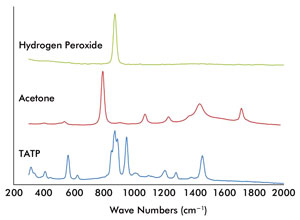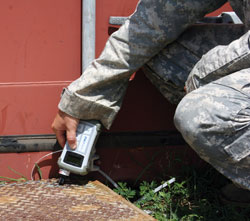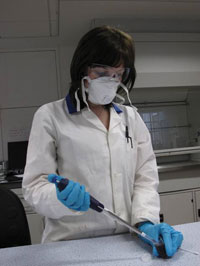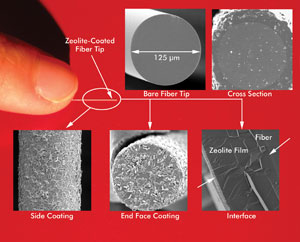It isn’t time to retire bomb-sniffing dogs – yet. However, that scenario is closer to happening, thanks to advances in surface-enhanced Raman spectroscopy, hyperspectral imaging and other photonics technologies. Armed with these, police and military personnel will be able to do quick checks to uncover explosives and chemical or biological agents from a distance and up close.
Photonics at the core
Adam Bingham, a research scientist at ICx Technologies Inc. in Arlington, Va., noted that the company’s explosive-, narcotic- and chemical agent-detecting products have something in common. “All of our Fido products have a photonic backbone in them.”

The Raman spectrum of the explosive triacetone triperoxide (TATP) is clearly different from those of its two main constituents. The difference enables the explosive to be identified by matching spectra against a library. Courtesy of ICx Technologies.
For trace detection, ICx employs a proprietary amplifying fluorescent polymer that quenches its emission in the presence of a chemical of interest. The approach works for the telltale vapors given off by a chemical as well as for the solid particulates containing it. By measuring the decline in fluorescence, the technique enables detection of nitroaromatic explosives in the parts-per-quadrillion range. That sensitivity, the company says, is comparable to that of a highly trained dog.
A different approach is found in a handheld unit designed to identify explosives, liquid threats and narcotics. These devices exploit Raman spectroscopy, using a diode laser operating at 785 nm to excite a response from the unknown material. By looking at the spectral signature from just above 785 nm to about 930 nm and comparing that to a library of known agents, the device can identify the unknown substance.

A National Guardsman samples a spill, using a handheld device and Raman spectroscopy to identify the liquid. Courtesy of ICx Technologies.
The method is not for trace detection, and it works only on solids and liquids. It does not require touching the unknown, but the container must be transparent to the laser and the Raman signal.
Bingham noted that improved matching algorithms would make identification more certain. A second area of possible improvement involves photonics technologies, particularly detectors. ICx currently uses silicon-based CCDs, but these work only to approximately 1 µm, and their response falls off as that limit is approached.
“If you had a better detector, you could either use less laser power or you could extend your spectral bandwidth. That would definitely be an area that could give you a lot of advantages in capability,” Bingham said.
Tiny particles, big sensitivity
Another type of photonics-based test is being developed by researchers at Queen’s University Belfast in Northern Ireland, UK. The idea is to bring the benefits of surface-enhanced Raman spectroscopy to the field through the application of techniques originally investigated by Queen’s pharmacy professors for drug delivery.

Researchers at Queen’s University Belfast want to use gold nanoparticles in a gel as part of an explosives detector based on surface-enhanced Raman spectroscopy. Courtesy of Steven E.J. Bell, Queen’s University Belfast.
Steven E.J. Bell, research director of the innovative molecular materials group in Queen’s School of Chemistry and Chemical Engineering, heads the development team. He noted that surface effects can boost a Raman signal a million times or more, making it suitable for detecting trace amounts of an explosive or narcotic. The challenge has been turning that potential into something suitable for use by laypeople outside a lab.
The proposed solution at Queen’s begins with a special gel loaded with colloidal gold or silver nanoparticles. These will be chemically functionalized so that they preferentially absorb particles containing the compound of interest. The nanoparticles will produce a surface-enhanced Raman signal, making trace detection possible.
In use, the gel will be loaded onto pads that will be swiped across suspect surfaces and read by a field Raman instrument.
It is important that the gel be transparent to both the excitation laser and the Raman signal. It also is important that the specificity of the test be high.
The researchers are aware of the capabilities of current Raman instruments and what should be possible in the next few years, Bell said. “We’re trying to develop chemistry that will fit with the performance levels that we believe will be available.”
He expects to have a working prototype within a year or so. It’s too early to know what the detection limits might be, but the technique must be only sensitive enough for the job.
In the hole
A different detection tactic is being taken by a group from the Missouri University of Science and Technology in Rolla, working in conjunction with researchers from the University of Cincinnati. The team is working with zeolite, aluminosilicate crystals with subnanometer-scale pores that can absorb molecules. The absorption causes a change in the zeolite’s properties. Among the characteristics that change is the material’s refractive index or its reflectivity (see “Fiber Sensor Provides Real-Time, Continuous Monitoring,” Photonics Spectra, December 2005, page 92).

Zeolite’s subnanometer-size pores trap molecules, enabling detection of explosives via an optical fiber. Courtesy of Hai Xiao, Missouri University of Science and Technology.
Hai Xiao, an associate professor of electrical and computer engineering who heads up the Missouri group, noted that the selectivity for specific molecules depends upon geometry and chemistry. “You can design a different size of the pore, and then you can design the absorption property.”
As for the readout, that can be done either optically or electrically. For the latter, what the researchers look for is a change in capacitance. For the former, various optical methods, including refractometry and spectroscopy, are possible.
The group currently is developing sensors for the military that are tiny enough for portable, battery-powered devices. These wirelessly networked instruments then would be deployed on a battlefield or in an urban setting and would report on current environmental conditions.
Xiao noted that, for such an application, an all-electrical detection method offers integration advantages, largely because no laser or detector is required. However, a photonics method may offer better selectivity and results. Further research and development is needed before a decision about the best approach can be made.
At a distance
Finally, there are photonics techniques that offer the ability to detect explosives or other dangerous agents at some standoff distance. This capability is particularly important when a wide area must be quickly searched or when conditions are unsafe for personnel.
One method involves hyperspectral imaging, an approach that captures a signal across a wide swath of spectrum. The signal then can be compared to a known library for identification or used to spot anomalies.
ICx is developing a thermal infrared method, working in conjunction with the privately held Spectrum Photonics Inc. of Honolulu. The technique is passive, since everything glows in the 8- to 12-μm spectral range that is being used. In addition, these wavelengths yield information specifically related to chemical bonds, enabling classification of the compounds present. Plans call for a product based on the technique to be available within a year.
Edward T. Knobbe, president of Spectrum Photonics, noted that the technique works best for chemical agents. He said more work is needed before it becomes practical for biological ones because, at present, their spectral signature is not distinct enough.
Because everything emits at these wavelengths, it is necessary to filter out the background signal. But once that is done, hyperspectral imaging offers some benefits, he said. “One of the big advantages of the hyperspectral is very, very wide angular range of detection and very fast search time.”
He noted that it also can be combined with and complement other techniques, such as active lidar. To be useful, however, hyperspectral imaging systems will have to be much lighter, smaller and less costly than current technology. For that reason, Spectrum Photonics is concentrating on dramatically improving those areas, Knobbe said.